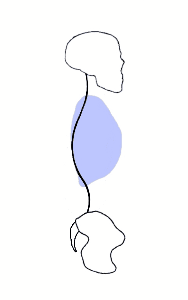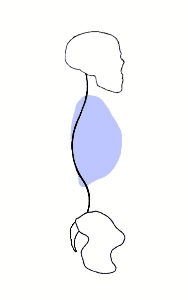Healthy Breathing Explained
Spinal - Cranial - Pelvic/Sacral Response

When you take a breath the spine responds . . .
With the in-breath the spine lengthens. The spinal curves become more shallow. Upon inhalation, as the secondary spinal curves become more shallow, there are also two significant secondary effects:
Because it's useful. It's basic bio-mechanics, after all. But, how'ya doing with that? Check to see how you breathe. Take a breath. Go ahead.
Notice whether you pull your shoulders back, arching your back, pulling your head backward/raising your chin? A lot of people breathe that way.
That's wrong! Here's why. First, you are not really getting your full lung capacity. Also, the body is not moving in response to the the action of the lungs filling up, but initiating the movement with muscles that don't need to do that work. It is inefficient, energy draining. And, over time, that pattern of pulled back shoulders, arched back, cocked head gets set into the pattern of you flesh. Then it's just something to drag around, limiting your vitality, range of motion, and sense of ease and power. You might not be able to put a finger on it, but it looks, well . . . off.
Here's what extrinsic breathing looks like. Doctor says, don't do that!
Spinal - Cranial - Pelvic/Sacral Response

When you take a breath the spine responds . . .
With the in-breath the spine lengthens. The spinal curves become more shallow. Upon inhalation, as the secondary spinal curves become more shallow, there are also two significant secondary effects:
1. As the lower lumbar curve/lower back lengthens the sacrum
moves downward, the tail bone tucks under slightly, and the pelvis rolls
backward.
2. As the upper cervical spine/neck lengthens, the head tilts downward slightly with the jaw moving inward. The gif above and the image below show all that.
Why is this important for you to know?
Because it's useful. It's basic bio-mechanics, after all. But, how'ya doing with that? Check to see how you breathe. Take a breath. Go ahead.
Notice whether you pull your shoulders back, arching your back, pulling your head backward/raising your chin? A lot of people breathe that way.
That's wrong! Here's why. First, you are not really getting your full lung capacity. Also, the body is not moving in response to the the action of the lungs filling up, but initiating the movement with muscles that don't need to do that work. It is inefficient, energy draining. And, over time, that pattern of pulled back shoulders, arched back, cocked head gets set into the pattern of you flesh. Then it's just something to drag around, limiting your vitality, range of motion, and sense of ease and power. You might not be able to put a finger on it, but it looks, well . . . off.
Here's what extrinsic breathing looks like. Doctor says, don't do that!
Healthy breathing is sometimes called core breathing. The simple hallmark of healthy breathing is this: It is effortless. The body responds to the movement of the breath. In contrast to this there's surface, or extrinsic breathing. There the body parts move first in an effort as if to aid breathing. As if. Note well: effort. As in, energy. Not necessary.
So what?
One key point is that if you do not have core, intrinsic breathing activated in your system you are wasting energy. All that pulling shoulder, arching the back, bringing the head up and back . . . that gets patterned into the body over time. And then, the very pattern you used thinking it was facilitating your breathing, it's actually making it harder to breathe! I bet you did not see that coming?
Consequently, you are not receiving the natural benefit of keeping the necessary healthy flexibility in the lower back and hips. Also, the lengthening of the neck on the in-breath maintains a healthy flexibility and ease of the head and shoulders. The shoulder and hip girdles stay young and flexible with correct breathing.
What to do?
Sit straight on a chair with a firm surface for a few moments regularly. (If you are tall check out the tip for chair height below.) Find your sit bones; they're directly under your buttocks as you sit on the chair. As you breath in, notice how the body moves. Particularly, the rib cage, the shoulders, the lower back, the hips and the head and neck.
The practice of noticing itself may be new to you. Be patient. If you don't sense any movement in the lower back/hips, mock it up by tucking your tail bone under/rocking the pelvis backward slightly on the in-breath. Then, rocking the pelvis forward slightly/letting the lower back arch on the out-breath. That will put some healthy oil into the lower back and the junction with the lumbar spine and the pelvis. Once you have that down, on the inhale, also lengthen the back of the neck/let your jaw drop downward and in slightly. On that latter point about the jaw, that's let it drop and move in. Don't pull it down. The initiation comes from lengthening the back of the neck. No effort, remember.
For us tall and short folk:
Chairs in general are scaled for an average height person. If you are tall, chances are the average chair is too low for you. Short, you know how your feet dangle off the floor. In any event, proper stable sitting requires your feet to be solidly on the floor.
When a chair is too low, it takes muscular effort to sit upright, and the temptation is to slouch. And, you can probably imagine what slouching does for your breath. Too high, you are not grounded.
Look. We're not saying not to sit in whatever chair you happen to have. Just when you make the effort to spend some time regularly, consciously sitting and breathing in the way discussed above, it behooves you to sit on a chair with the proper height. Believe me, if you do take up the practice of regularly sitting, breathing, and seeing what happens, you'll thank me and sing my praises when it becomes a habit and starts to bear fruit for your health, healing, vitality, awareness, and presence. No joke.
So how to figure the right chair height?
Here's my formula:
While seated on a firm surface place your feet in front of you, with the lower legs straight up and down. Now measure the distance from the floor just behind your heel to the place way up in back of the knee solidly touching the upper leg. Round up the measurement to whole inches. And . . . add one (1) inch more. That measurement will give you a chair height appropriate for your individual build. If you need convincing about the value of this, click to read an excellent article on the subject. You will be a believer.
From here you're on your own. Most chairs are manufactured to measure in at 17.5 to 18.0 inches. If you want a proper chair for the kind of mindful sitting being suggested here, you may have to have one made, or cut one down to size. A simple option would be a simple wood stool with the legs cut to give you the correct height. Other than that, an online search will give you lots of options.
NB: We're not talking about adjustable office type chairs, but something with a rather firm surface. That firm surface is necessary to feel those sit bones and to get the most out of your mindful sitting exercise.
Happy Sitting!



No comments:
Post a Comment